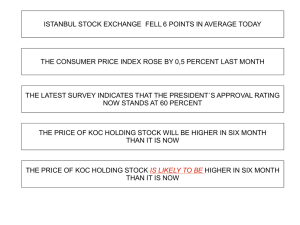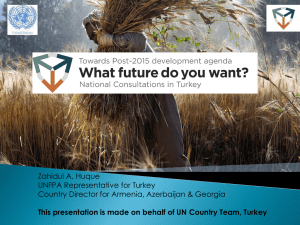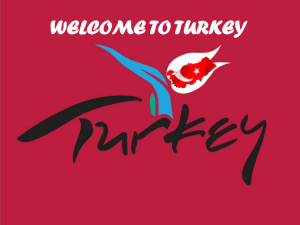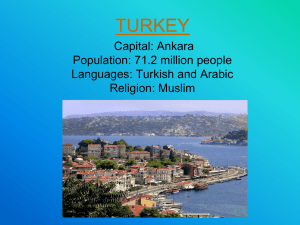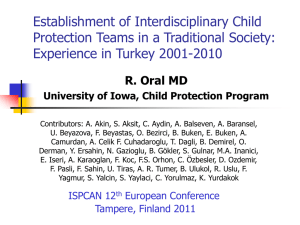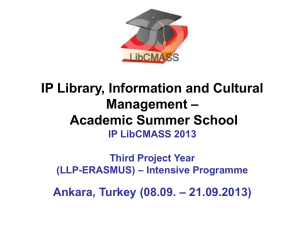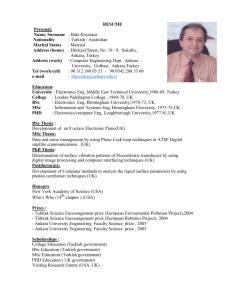a pilot project on agricultural water management in turkey
advertisement
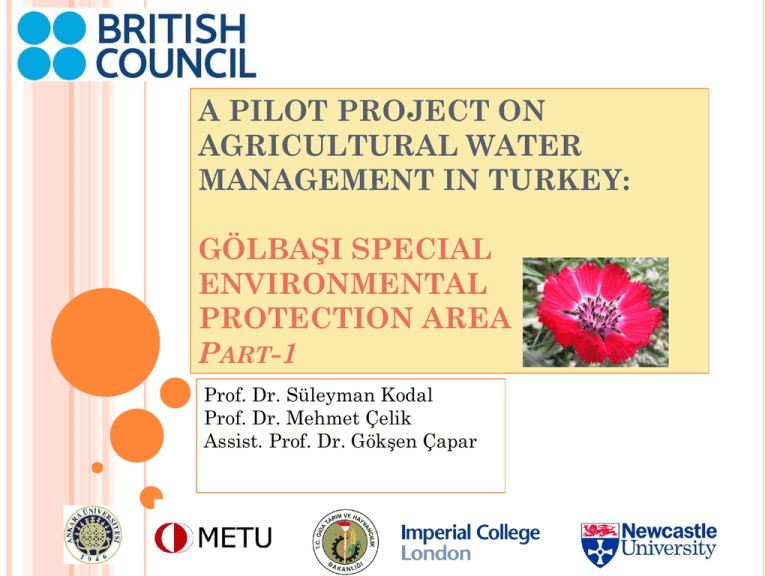
A PILOT PROJECT ON AGRICULTURAL WATER MANAGEMENT IN TURKEY: GÖLBAŞI SPECIAL ENVIRONMENTAL PROTECTION AREA PART-1 Prof. Dr. Süleyman Kodal Prof. Dr. Mehmet Çelik Assist. Prof. Dr. Gökşen Çapar HE PARTNER INSTITUTIONS TURKEY Ankara University Water Management Institute Dept. Farm Structures and Irrigation Dept. Geological Engineering UK Middle East Tech. University Dept. Environmental Engineering Dept. Chemical Engineering Imperial College, London Department of Chemical Engineering Newcastle University School of Agriculture, Food and Rural Development RESEARCHERS TURKEY UK Ankara University Imperial College, London Assist. Prof. Dr. Gökşen Çapar Prof. Dr. Kang Li (Team Leader) (Team Leader) Prof. Dr. Süleyman Kodal Dr. Zhentao Wu Prof. Dr. Mehmet Çelik Dr. Francisco R Garcia Garcia Dr. Şebnem Arslan Dr. Ben Kingsbury Cenk Akşit Rami Faiz METU Ana Maria Gouveia Gil Prof. Dr. Ülkü Yetiş Nur Hidayati Othman Prof. Dr. Levent Yılmaz Tao Li Gölbaşı GDDFAL Newcastle University Erdoğan Ataberk Reader John Gowing Orhan Gönenç Dr. Mike Palmer ANKARA UNIVERSITY A public university. First higher education institute of the Republic of Turkey. Vast experience for 66 years, highly qualified academic staff and students, well established teaching, learning and research facilities: 14 faculties, 13 institutes, 7 vocational schools, 2 colleges, 36 research centers, 1 state conservatory, 1 prep school located in a total of 12 campuses. WATER MANAGEMENT INSTITUTE (ENSTITU-SU) Enstitu-Su is one of the brand new institutes established by Ankara University. It was established in 2010 to provide new insights and suggestions to water-borne problems in our country and in the world. Located in Golbasi 50th Year Campus. Limited human resources: Director Assistant Director 2 Faculty Members Institute Secretary 2 Officials Limited space (6 offices, 1 meeting room). Limited research facilities (no lab.). Education has not started yet. INTERNATIONAL PROJECTS-1 Project Name A Pilot Project on Agricultural Water Management in Turkey: Golbasi Special Environmental Protection Area Collaborating Countries Turkey-UK Sponsor British Council (Knowledge Partnership Programme) Duration 1 year (April 2012- May 2013) Budget 22 000 GBP Partner HEIs Ankara University Water Management Institute Middle East Tech. Unv. Golbasi GDDFAL Imperial College, London Newcastle University INTERNATIONAL PROJECTS-2 Project Name Adaptation to Climate Change in Golbasi Region of Turkey via Rainwater Harvesting and Efficient Water Use Sponsor United Nations UNDP and COCA-COLA PARTNERSHIP “EVERY DROP MATTERS” Programme Duration 1 year (October 2012- October 2013) Budget 116 000 USD Scope Construction of rainwater harvesting system and drip irrigation system in Golbasi region. Construction of an automatic meteorology station. Construction of a demonstration area for training of farmers. PROF. DR. SULEYMAN KODAL ANKARA UNV. FARM STRUCTURES AND IRRIGATION DEPT. DISKAPI ANKARA TURKEY TEL: + 90 312 596 1217, FAX: + 90 312 316 7467, E-MAIL: KODAL@AGRI.ANKARA.EDU.TR BS, MS, PhD in Farm Structures and Irrigation (Ankara Unv.) Taught courses; Research areas: Hydraulics Engineering Mechanics System Engineeering Irrigation Methods Irrigation Scheduling Techniques Irrigation, irrigation management Plant water consumption Agrometeorology Optimization techniques Supervised 5 MS, 5 PhD students Over 40 publications in international and national journals Several proceedings (international + national) PROF. DR. MEHMET ÇELIK ANKARA UNV. GEOLOGICAL ENG. DEPT. TANDOGAN ANKARA TURKEY TEL: + 90 312 203 3372, FAX: + 90 312 215 0487, E-MAIL: CELIKM@ENG.ANKARA.EDU.TR BS, MS in Geological Engineering (Selcuk Unv.) PhD Geological Engineering (Ankara Unv.) Taught courses; Hydrogeology Geological mapping Engineering project Groundwater chemistry Karst hydrogeology Thermal and mineral springs Well hydraulics Environmental pollution Research areas: Hydrogeology Karst hydrogeology Geothermal springs Well hydraulics Hydrogeology Environmental hydrogeology Groundwater-surface waterseawater interaction Supervised 10 MS, 1 PhD students 19 publications in international journals, 4 publications in national journals Several proceedings (international + national) ASSIST. PROF. DR. GOKSEN CAPAR ANKARA UNV. WATER MANAGEMENT INSTITUTE GOLBASI 50TH YEAR CAMPUS BLOCK L FLOOR 2 ANKARA TURKEY TEL: + 90 312 600 0100/1544, FAX: + 90 312 485 2208, E-MAIL: GCAPAR@ANKARA.EDU.TR BS, MS, PhD in Environmental Eng. (Middle East Technical Unv.) Post-graduate study in Imperial College, London Statistical Methods for Engineers, Solid Waste Disposal (METU; 2006-2008) Research areas: 9 months in 2004; membrane reactors fro oxygen removal from ultrapure water (Supervisor: Prof. Dr. Kang Li, Chem. Eng. Dept.) Taught courses; Teaching Assistant (1997-2004) Water and wastewater treatment/reuse; Physicochemical processes; adsorption, membrane processes (Textile wastewater reclamation; Disinfection by-products in drinking waters) Downstream processing; Silk processing effluents (Protein recovery, Bioseparation) Co-supervised 1 MS student 13 publications in international journals (SCI), 3 publications in national journals Several proceedings (international + national) A PILOT PROJECT ON AGRICULTURAL WATER MANAGEMENT IN TURKEY: GÖLBAŞI SPECIAL ENVIRONMENTAL PROTECTION AREA RATIONALE OF THE PROJECT-1 TURKEY IS NOT RICH IN WATER RESOURCES Turkey is not an affluent country in terms of water resources, hence precautions should be taken to avoid water stress in the future. The total potential available water resources from surface flow and groundwater amounts to 112 billion m3 per year. The available water per capita per year is about 1/5 of the water-rich countries and it is decreasing due to relatively high growth rate of population. It is estimated by the experts that, in 2030, the amount of available water will likely be around 1000 m3/capita/year. For the accurate management of water resources, water quality and quantity should be managed simultaneously. Water potential available per capita (m3/capita) WATER STRESS INCREASING IN 4000 TURKEY 3000 2000 4000 1499 1000 1120 0 1960 2012 2030 Water richness of some countries with respect to water poverty index Country Resource Access Capacity Use Environment Water poverty index Finland 12.2 20.0 18.0 10.6 17.1 78.0 UK Germany 7.3 6.5 20.0 20.0 17.8 18.0 10.3 6.2 16.0 13.7 71.5 64.5 Congo (Rep.) 17.1 10.3 11.8 7.3 10.9 57.3 Turkey 7.8 14.8 13.1 10.7 10.1 56.5 Nigeria 7.4 7.5 8.5 10.4 10.1 43.9 The Water Poverty Index: an International Comparison, Peter Lawrence, Jeremy Meigh and Caroline Sullivan, Keele Economics Research Papers, Keele Unv, 2002. WATER QUALITY MAP OF TURKEY Source: Ministry of Environment and Forestry General Directorate of Environmental Management, 2006. (mentioned under the title of Freshwater in EEA, SoER 2010) RATIONALE OF THE PROJECT-2 TURKEY IS CANDIDATE FOR THE EUROPEAN UNION Turkey is a candidate country to the European Union (EU) and therefore responsible for adopting the environmental policy of EU and transposing the related legislation. The Water Framework Directive (WFD) (2000/EC/60) requires all inland and coastal waters in member countries to reach “good status” by 2015. The WFD promotes the integrated management of water resources to support environmentally sound development and reduce problems associated with excessive water abstraction, pollution, floods and droughts. RATIONALE OF THE PROJECT-3 GOLBASI IS A SPECIAL ENVIRONMENTAL PROTECTION AREA Gölbaşı district is located at a distance of 20 km south of Ankara city. Gölbaşı was declared as a Special Environmental Protection Area (SEPA) in 1990 to protect the natural assests of the district. Gölbaşı SEPA consists of Gölbaşı Town, one sub-district and 10 villages. The population and area of Gölbaşı SEPA is 40803 and 274 km2, respectively. The most important natural components of Gölbaşı SEPA are Mogan and Eymir Lakes basin, which covers an approximate area of 971 km2. Mogan and Eymir Lakes are natural interconnected dam lakes formed behind alluvial barriers. Mogan and Eymir Lakes cover a surface area of 5 km2 and 1.2 km2, respectively. These lakes have ecological and recreational significance, and the wetlands and moorlands in the close surroundings are under protection. 488 endemic plant species and 200 bird species exist in Gölbaşı SEPA (some of them must be protected under Bern Agreement). Cornflower (Centaurea tchihatcheffii) Population: Gölbaşı SEPA: 40803 Gölbaşı district (2010): 95109 Area: Gölbaşı SEPA: 274 km2 Gölbaşı district: 738 km2 Mogan and Eymir basin : 971 km2 Mogan Lake surface area: 5 km2 Eymir Lake surface area: 1.2 km2 RATIONALE OF THE PROJECT-4 GOLBASI SEPA HAS MANY WATER PROBLEMS The lakes are under the pressure of intense pollution, caused mostly by urbanization, agricultural industry and recreational use. The district is not rich in water sources available for agricultural use. Groundwater potential of Ankara city is 200 million m3 as of 2006 and the groundwater management reserve of Gölbaşı district is 2.23 hm3/year. In recent years, the demand for groundwater has increased in the district, especially for irrigation purposes (Ankara SoER, 2009). In the district, there are creeks feeding the lake, however they mostly dry in summer. Moreover, the lakes are inadequately fed by groundwater. There is also salinity and boron contamination problem in all groundwaters in the district. Therefore, all groundwater sources are not suitable for irrigation and livestock drinking. GOLBASI-METEOROLOGICAL Station DATA Altitude (m) Years Precipitation (mm) Temperature (mm) Evaporation (mm) Eymir Lake 1011 1995-2000 395 - - Ankara 894 1926-2002 383 11.7 1152 Dikmen 1075 1961-1994 450 11 - Günalan 1230 1972-2000 394 - 1324 İkizce 925 1966-2001 401 9.5 - Haymana 1225 1929-1991 447.5 10.1 - Turkey annual average precipitation (1970-2000): 638.2 mm Rehabilitation studies of Sukesen Creek is completed by the Golbasi Municipality. The canal is renovated and the Creek, which collects water from Gerder and Orencik villages and ends in Mogan Lake is cleaned. Su Kesen Creek was previously flowing like a mud and carrying many polluters into the lake. RATIONALE OF THE PROJECT-5 AGRICULTURE IS THE MAIN WATER CONSUMER Agriculture sector is the largest water consumer in Turkey; irrigated agriculture currently consumes 75 percent of total water consumption, which corresponds to about 30 percent of renewable water availability. Demand for groundwater is rapidly increasing, especially in areas where there is a lack or an extreme shortage of surface water (e.g. Gölbaşı district). Agricultural water usage, applications of fertilizer and pesticides may negatively affect the water courses. WATER USE BY SECTORS IN TURKEY • 34 billion m3 in irrigation, 7 billion m3 in domestic water supply and 5 billion m3 in industry, totally 46 billion m3 of water was consumed in 2008. • This sum corresponds to only 41% of the available exploitable potential of 112 billion m3. • According to future projections, the share of irrigation use will decrease from 74% in 2008 to 64% by 2030. On the other hand, the domestic and industrial use would increase to 16% and 20% in this period, respectively. Source: General Directorate of State Hydraulic Works International Agriculture Fair in Turkey New Research and Development Plant in Golbasi for production of ecological oyster mushroom. Gölbaşı Mayor Yakup Odabaşı visits Poultry Research Institute of Ministry of Food Agriculture and Livestock for the opening ceremony of new hatchery (Capacity 30000 chicken). RATIONALE OF THE PROJECT-6 ANKARA UNV. 50TH YEAR CAMPUS NEEDS WATER Gölbaşı 50th Year Campus of Ankara University was put into service in 2008. It is still under development and construction continues. The area of the campus is 700 decares. Currently there are 2500-3000 students and 250 personnel in the campus. These numbers are expected to increase as new departments will move (or established). Forestration activities take place and great importance is given to the landscape. At the moment, 3000 trees, ornamental plants and grass are irrigated. The water need of the campus is 200 m3/day at the moment, and drinking water (municipality water) is used for this purpose due to water scarcity and boron contamination problem in the district. Irrigation with drinking water is quite costly.There is an urgent need to find another water source for irrigation of the campus area. State Hydraulic Works reports that the hydrogeological characteristics of Gölbaşı region where the Campus area is located, is “very low permeable and very limited ground water potential” If groundwater source is decided to be used, then boron removal will be required. The quality of groundwaters used for irrigation should be controlled and treatment should be applied where necessary. Construction of a reverse osmosis (RO) plant in Gölbaşı Campus for boron removal would be useful. The technical experience gained with the RO plant for boron removal in Gölbaşı Campus would be a good example for farmers in the district. Water Management Institute will play a key role in advising the local enterprises and farmers about the removal of boron from their water sources. Technology Development Zone near 50 th Year Campus European University Association visited Gölbaşı district as part of their study visit to Atilim University. The Mayor Yakup Odabaşı mentioned that there are 3 big universities in Gölbaşı, and the fourth one is under construction.
